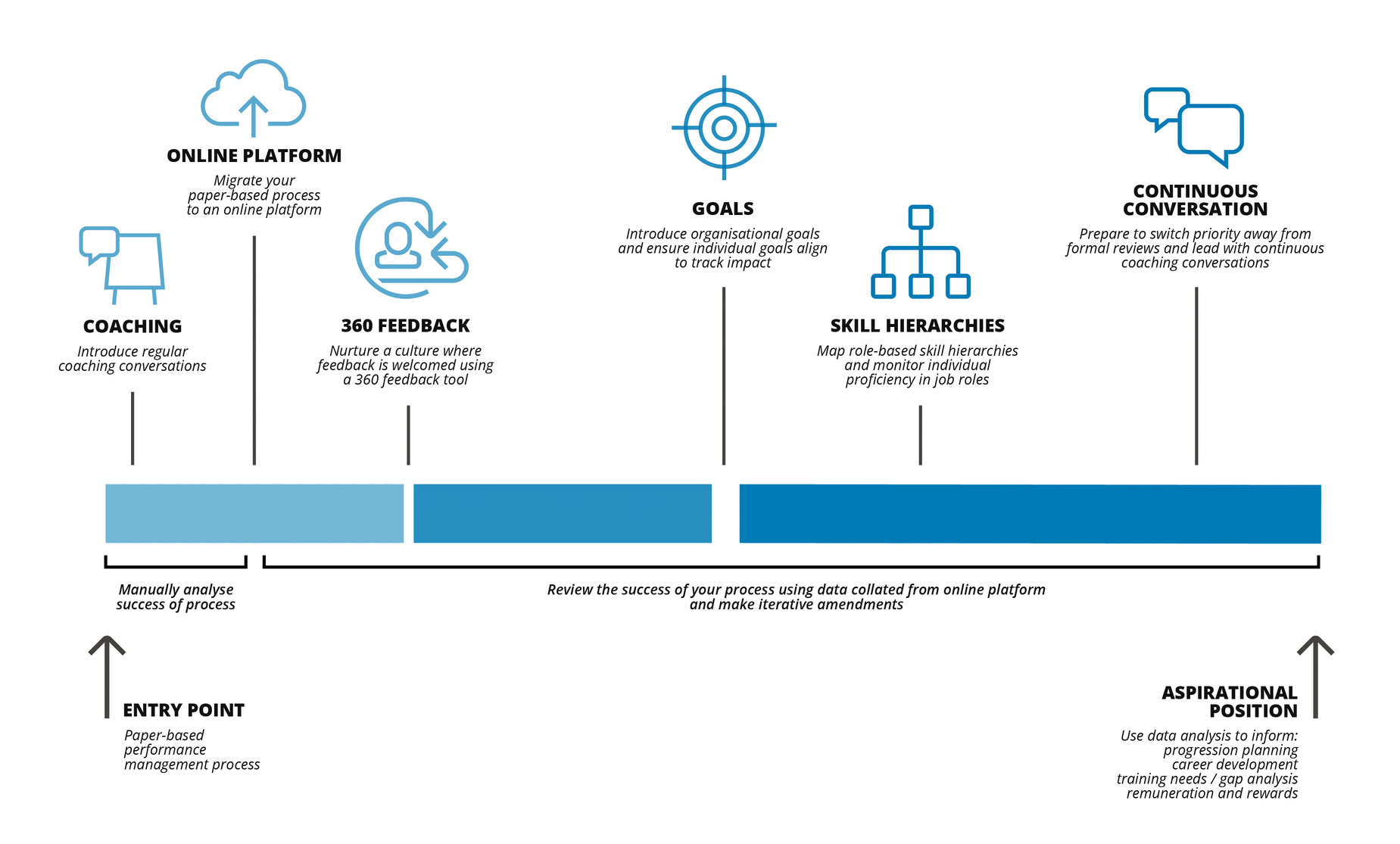Did you know that 95% of managers believe annual performance appraisals are ineffective ?
This is especially worrying considering the amount of time taken up by appraisal meetings, completing forms and collating and moderating ratings – around 210 hours a year per manager, according to the Corporate Executive Board.
That said, there is still a place in many organizations for a more formal review process.
Using a continuous performance management framework within an online platform means that formal performance reviews or appraisals will now benefit from having real data and evidence from system reports covering the required time period.

As your check-ins become more frequent, you may find that you rely less on formal, annual reviews, with day-to-day conversations taking precedence.
That’s not to say that annual appraisals can’t still have a place in the framework. As feedback occurs more often, it feels more natural for both manager and employee, who can develop more of a healthy, authentic workplace relationship.
The processes include near-term goal setting, regular check-ins and feedback. We’ve covered objective/goal setting and feedback in previous blogs, so this one will concentrate on check-ins.
The basics of effective continuous check-ins
Check-in meetings give both managers and team members the time and space to discuss issues, share feedback, build a strong working relationship and monitor progress towards agreed goals.
When conducting check-ins make sure you:
-
Schedule meetings on a regular interval for the next 6-12 month period
-
Never miss a meeting – reschedule but do not cancel
-
Always cover the team member’s agenda first, then follow up with any other discussion points
-
Take time to build rapport, talk about job satisfaction, development needs and then progress towards agreed goals.
-
Take notes during the meeting and follow-up on action items at the next meeting
The when/where/how
The frequency of check-in meetings is largely dependent on the number of team members and the complexity of the work at hand. Meetings should be held in a private space, avoiding distractions.
So an office or meeting room, rather than an open coffee area or canteen. The meeting should aim to be 15 minutes but take longer if needed.
Preparation
Always take time to prepare. Refer to notes from the last meeting – any progress/lack of progress to discuss? Then share any:
-
Positive feedback
-
Constructive feedback
-
Feedback for the manager
-
Organizational issues and news
-
Project-specific direction (e.g. schedules, priorities and workloads)
-
Opportunities for development
-
Project or task delegation
It’s a good idea to create a simple template that can be used to consistently capture notes, data and actions across all meetings.
Guiding your check-in conversations
Even the best performance management process won’t handle day-to-day conversations for you. Fortunately, Dr. Tim Baker originated this replacement for the traditional performance review system; it consists of five 10-minute conversations between managers and employees held over a six-month period.
The five themes of conversation are:
|
Date |
Topic |
Content |
Key Questions |
|
Month 1 |
Climate review |
Job satisfaction, morale and communication |
How would you rate:
|
|
Month 2 |
Strengths and talents |
Efficiently deploying strengths and talents |
What are your strengths and talents? How can these be used in your current and future roles? |
|
Month 3 |
Opportunities for growth |
Improving performance and standards |
Where are opportunities for improved performance? How can I assist you to improve your performance? |
|
Month 4 |
Learning & development |
Support and growth |
What skills would you like to learn? What learning opportunities would you like to take? |
|
Month 5 |
Innovation and continuous improvement |
Ways and means to improve the efficiency and effectiveness of the business |
What is the one way that you could improve:
|
Conclusion
Performance management has attracted far more attention as new methods and tools have become available. Engagement and enablement of people are now firmly understood as critical strategic differentiators for organizations. Yet there is a lot of improvement still required.
Mercer’s study on performance management practices revealed just 2% of companies feel their performance management approach delivers exceptional value and just 3% have excellent feedback practices. And 70% say there is a need to improve the link between performance management and other talent decisions.
As we’ve seen, overly simplistic or complicated performance management processes can slow progress for employees, reduce motivation and morale and negatively impact individual productivity and development.
Organizations today are recognizing the challenges raised by the traditional annual appraisal or end-of-year review process, and are seeking out modern ways to support performance.
The techniques and tools used to support modern performance management include OKRs, check-ins, 360 feedback and SMART goals, all of which can work together to build a positive feedback culture.
Continuous performance management checklist:
-
The organization has a clear, shared vision that is understood by all employees
-
Goals are set using OKRs and regularly reviewed to ensure they align with corporate agendas
-
Managers and staff are comfortable with exchanging feedback (and use frequent check-ins to do so)
-
Automations (enabled by an agile performance management system) are in place. Not to state the obvious, but a paper or document-based process will hinder efficiency
-
Progression towards goals is easily tracked by managers and staff
-
The organization helps employees succeed in their current roles and towards potential roles within the business


